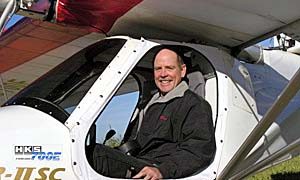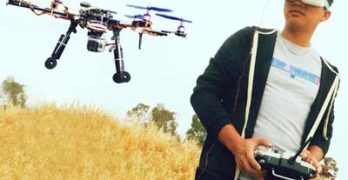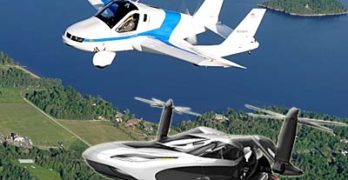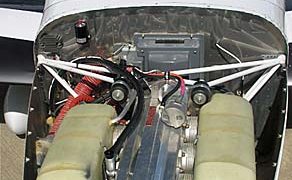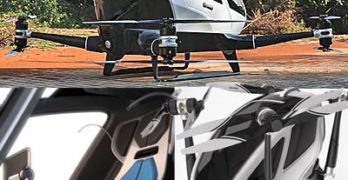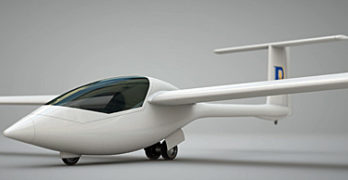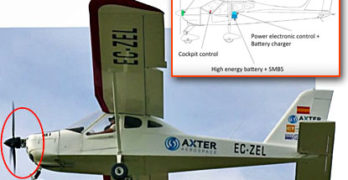For thirteen years, ByDanJohnson.com has served the light aircraft community, covering Light-Sport Aircraft, light kit-built aircraft, and ultralight aircraft. Along the way, we’ve covered all manner of interesting light aircraft from the tiniest drones to the emerging new-style certified GA aircraft from producers of LSA. As my outgoing webmaster said, “It’s been quite a ride!”
Of, course, since ByDanJohnson.com has been live for 13 years (almost to the day, which will be April 1st, 2017), this website preceded social media and even giants like YouTube. The website you have been so loyally visiting was assembled using the fairly crude tools available at the beginning of this new millennia. However, now that we are 17 years into the new century, it is time for a change… a BIG change.
In just a few days, after we check and recheck, adjust and tweak, we will hit the button for our “beta launch” of an entirely new look and feel.
Search Results for : drone
Not finding exactly what you expected? Try our advanced search option.
Select a manufacturer to go straight to all our content about that manufacturer.
Select an aircraft model to go straight to all our content about that model.
The Future of Flying… Could It Happen?
Two forms of flying are racing at us at increasing speed. This is both scary and promising at once. What can we expect? My crystal ball is no better than yours, but let me tell you what I can imagine may be headed our way.
I refer to two generally unrelated activities in the air: autonomous aircraft and FPV drones. Most pilots to whom I’ve spoken seem intrigued by these innovations and a few are enjoying their quadcopters, myself included.
Others are not so sure if they like the idea of either unmanned but man-carrying aircraft or a swarm of drones buzzing about the airport or neighborhood. I understand this viewpoint. Most of us treasure our privacy and don’t want it invaded.
Yet I invite you consider the following scenario… perhaps 3-10 years in the future.
Think about why you like recreational flying, in your LSA, light kit, or ultralight.
Big Airplane Companies and Autonomous Air Taxi
Are you interested in light aircraft? “Check.” Interested in cool looking flying machines? “Check.” Enjoy following the latest trends in flying? “Check.” Interested in autonomous (pilotless) flying? “Umm… Not sure?” Interested in an Autonomous Airbus Air Taxi? “Hmm… no, not really?” Interesting in getting your Eight-Engine Rating? “Ah, No!” However you answered and whatever you think, the world of aviation appears to be changing.
When a company like airliner giant Airbus goes after media coverage with its E-Fan and ups the ante with Vahana, some may begin to feel the ground move under their feet like a California earthquake. Imagine a fleet of pilotless vehicles ready to swoop in to pick up passengers and deliver them to doctor appointments or a visit to grandma’s house. Aviation appears to be headed in some very new directions.
On ByDanJohnson.com, I have followed other flying car or drone developments. See this article or here’s another for a couple examples.
Mainstream Media Awakens to Flying Cars
Perhaps like many of you, I read the newspaper most mornings. Today I was reading the Wall Street Journal. In one of their special sections was an article about flying cars. As regular readers know, I try to keep up with this niche within our niche of aviation.
Major publication reporters are finally catching up with what we have been observing for several years. People talk about the “mainstream media” disdainfully for a reason. Even though they provide the “news,” their realization of all things new is not necessarily that timely. So much is happening in so many fields that mainstream media reporters cannot be expected to keep up with all developments. A website like this one is laser-focused on Light-Sport Aircraft, light kit aircraft, and ultralights. Even a billion-dollar news organization can’t stay up on the latest like we can.
In fact, today’s “Journal Report” — a subsection of the daily newspaper — was all about aviation.
Toyota May Be Thinking Differently about Aerocars
Maybe you haven’t heard enough about electric-powered aircraft, flying cars, and automobiles on autopilot (presuming you’re aware of Tesla’s fatal accident in May). How about a shape-shifting aerocar? Huh?! I know it sounds rather crazy but Toyota, being the world’s largest car manufacturer, is not a name to be dismissed when they may choose to delve into the flying car business… twice, in a few months!
Nope, I’m not kidding. The Japanese car company was awarded a patent for a “Shape Morphing Fuselage for an Aerocar.” The illustrations — typical patent artwork — might fool you. This is not some 1930s silliness. The U.S. Patent office published this very recently, on June 23rd, 2016.
Perhaps it’s no more than a publicity generator, much like Amazon’s drone delivery aircraft — about which, by the way, Amazon claims to be sincere. Or, maybe Toyota is afraid Terrafugia might beat them to an interesting market, something like Tesla did to the big boys of auto manufacturing.
Flying Car Racing Event & Terrafugia New Weight
If my title confuses you, regrets. The two are related in my mind but not in present-day fact. Nonetheless, I found both interesting and hope you do, too.
First, the fact. Terrafugia, of current Transition Roadable Airplane or flying car fame, won a weight exemption up to 1,800 pounds. This blows past the 1,680 pound exemption won by Icon Aircraft for their A5 LSA seaplane (only 1,510 pounds of which they chose to use). Earlier Terrafugia was granted an exemption to the seaplane LSA weight of 1,430 pounds but that didn’t prove to be enough.
A problem, perhaps the major problem, for Terrafugia is contained in the Federal Motor Vehicle Safety Standards (and let’s be just as government as we can be to go with the inescapable abbreviation of FMVSS). You cannot take to the air with any airplane heavier than an ultralight vehicle (254 pounds empty plus certain exceptions) without satisfying lengthy FAA regulations and you cannot put a non-kit car on the road without meeting the considerable requirements of FMVSS.
Jabiru Engines’ Battle With Australian Government
Among all the engines that lift Light-Sport Aircraft and light kit aircraft into the air, a few names dominate the field. To be used in a Special LSA, the engine has to meet all the requirements of the ASTM consensus standards. That is tough enough that currently we have Rotax, HKS, Continental, and Titan, with even the Continental (like Lycoming) qualifying by virtue of those powerplants meeting FAR 33. The other major player is Jabiru… the engine company as distinct from the airframe producer. Other engine suppliers such as UL Power, and D-Motor (and perhaps more) could possibly qualify but have not completed the ASTM process at this time.
So, it was some surprise to many readers that in December of 2014, the Australian equivalent to FAA, called CASA, implemented restrictions on the operation of Jabiru-powered aircraft in that country. In the Sport Pilot magazine published by Recreational Aviation Australia, Dave Edmunds wrote, “These restrictions required passengers to sign a waiver indicating that they were aware of potential aircraft problems.” Some areas of operation of flights schools were also imposed.
Is the Future of Flight Autonomous?
As techies know the giant Consumer Electronics Show (CES) has been in the news over the last week and we’ve seen articles about cool stuff at the event. I don’t remember ever seeing anything about manned aircraft in CES coverage before though quadcopters have had a clear presence. At the 2016 event, though, one vehicle got a lot of attention: eHang 184, from China. You can check out their video below.
I found eHang very intriguing but I hesitate to call it an aircraft, at least compared to manned airplanes. It is more like an autonomous air vehicle and I say that because the occupant is not a pilot. As its developers tell the story, you get in, use the screen in front of you to tap where you want to go and eHang flies you to that destination. I’d be more likely to call it an “aircab.”
As currently portrayed and as seen at CES, eHang is something very different.
Innovative Hybrid: Jet Power with Electric Motor
Some people, myself included, love soaring flight. As the following article from Dave Unwin explains, to use his words, “Soaring flight exercises a fascination that is both difficult to explain and hard to resist, sometimes called ‘three-dimensional sailing.’ Flying a heavier-than-air machine for several hours and hundreds of miles by using the atmosphere as the fuel possesses an undeniable attraction.” As he further explained in a longer article, the downside is getting airborne for soaring flight. Various alternatives have been explored. Some were reasonable; others were too marginal to be enjoyed. In the following piece Dave tells about a new aircraft that might solve this problem, one that can fit England’s innovative SSDR 300 (kilogram) category. —DJ
Article Updated 6/17/15 — ProAirsport announced, “We have now released a priority price of 39,950 British pounds (about $63,000). More details can be found on our website.” This is an excellent value for a motorglider.
Add-On Electric Motor Emergency & Boost Power
A few years back at Aero 2009, Flight Design and Rotax teamed up on a very interesting project. Based on the R-912 engine they added an optional electric motor that could provide additional torque (a characteristic electric motors have in abundance) for takeoff and climb or for emergency power in the event of a failure. The idea more than intrigued me and many others but it quietly disappeared.
Recently a Spanish university announced it had taken this concept to the next step. The team investigating this seemed focused on the emergency factor but opened the door to combined used of electric motor and gasoline engine. In case of a conventional engine failure, while very unlikely, an electric motor can, they said, deliver another 20 kilometers or 12.5 miles of range. That would be a literally saving grace to the pilot and occupants of a troubled aircraft.
Researchers at Universidad Carlos III de Madrid (UC3M) and the Axter Aerospace firm developed an electric propulsion system to install in light aircraft to deliver extra power and range in emergency situations.
- « Previous Page
- 1
- …
- 3
- 4
- 5
- 6
- 7
- Next Page »


